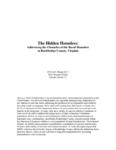The Hidden Homeless: Addressing the Obstacles of the Rural Homeless in Rockbridge County, Virginia

View/
Author
Stroud, Edward Simpson
Subject
Washington and Lee University, Shepherd Poverty Program
United States. Department of Housing and Urban Development
Rural poor -- Housing
Continuum of care -- Management
Metadata
Show full item recordDescription
Edward Simpson Stroud is a member of the Class of 2017 of Washington and Lee University. Capstone; [FULL-TEXT FREELY AVAILABLE ONLINE] Rural homelessness is an understudied subset of homelessness population in the United States. Yet, the rural homelessness has important distinguishing characteristics and barriers to care that make addressing the problems of this population more difficult than their urban counterparts. Given that rural communities face barriers of their own, HUD's Continuum of Care framework allows for such communities to overcome these barriers in the long-term. As such, there are a variety of ways in which a Continuum of Care can be devised to address the unique needs of each community's homeless population. Moreover, since rural homelessness differs from urban homelessness in important ways, communities, specifically Rockbridge County, should consider initial key factors as it begins to address its own population of rural homelessness. These factors include: invisibility and awareness consideration; coordination of services and diversity of needs; and scarcity of services and limited resources. As such, this paper argues that HMIS is the key driver for the process of Rockbridge County effectively addressing these three key factors, which in turn will lead to long-term implications for preventing homelessness in the community. Edward Stroud